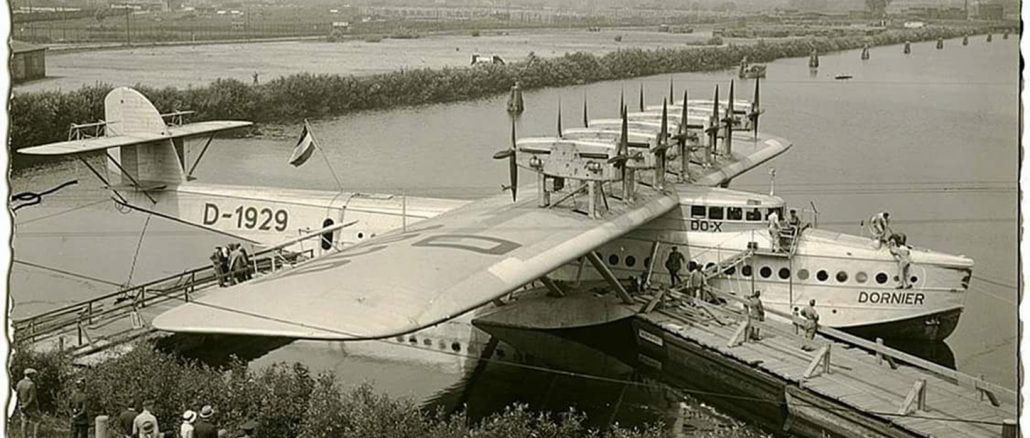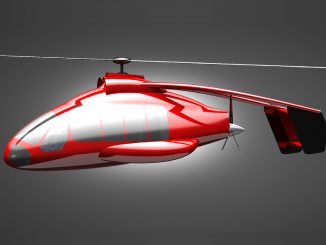
Designed by Dr. Claudius Dornier, the Dornier Do-X was the largest and heaviest flying boat in the world upon its completion in 1929, with a wingspan of 157 feet and a maximum take-off weight of more than 61 tons.
As the Treaty of Versailles forbade Germany from building certain classes of aircraft, the enormous aircraft was on the shores of Lake Constance in neighbouring Switzerland. The project was financed by the German Ministry of Transport.
The Do-X was powered by 12 Bristol Jupiter radial engines mounted in a tandem “push-pull” configuration atop the wing, which could just barely haul aircraft up to an altitude of 1 650 feet. True to its boat-like design, the Do-X’s complex engines were not directly controlled by the pilot — the captain in the cockpit had to send orders for throttle adjustments to a flight engineer in the engine room.
Capable of seating up to 66 people on long range flights or up to 100 on short flights, the aircraft was popular with the public, but a lack of commercial interest and a number of non-fatal accidents prevented more than three examples from being built. Of these one for Germany and two for Italy with the German flying boat being operated by Luft Hansa (the national airline at that time) for a short period of time before a landing accident took off the tail. Eventually it was put into a museum, before being destroyed during World War II.
The Do X took its first flight on 12 July 1929 with a crew of 14, and once carried a record number of passengers on a demonstration flight. This was the largest number of passengers on one flight and that record was to stand for 20 years.
The record was set on its 70th test flight on 21 October 1929, of the 160 on board 150 were passengers, ten were aircrew and nine were “stowaways” who did not hold tickets. After a take-off run of 50 seconds the Do X slowly climbed to an altitude of 200m (650ft). As a result of its size, passengers were asked to crowd together on one side or the other to help make turns. It flew for 40 minutes at a maximum speed of 170km/h (105mph) before landing on Lake Constance.
In 1930-1931 the aircraft flew from Germany to New York via points in Europe and West Africa to Brazil and then onto the USA where it spent nine months before returning to Germany. The test flight took the Do X to the Netherlands, United Kingdom, France, Spain, and Portugal. The journey was interrupted at Lisbon on 29 November, when a tarpaulin made contact with a hot exhaust pipe and started a fire that consumed most of the left wing. After sitting in Lisbon harbour for six weeks while new parts were fabricated and the damage repaired, the flying boat continued along the Western coast of Africa and by 5 June 1931 had reached the islands of Cape Verde, from which it crossed the ocean to Brazil and from there to New York.
Design
The Do X was a semi-cantilever monoplane with an all-duralumin hull and with wings composed of a steel-reinforced duralumin framework covered in heavy linen fabric, covered with aluminium paint.
It was initially powered by twelve 391 kW (524 hp) Siemens-built Bristol Jupiter radial engines, with six tractor propellers and six pushers mounted in six strut-mounted nacelles above the wing. The nacelles were joined by an auxiliary wing whose purpose was to stabilise the mountings.
The luxurious passenger accommodation approached the standards of transatlantic liners. There were three decks. On the main deck was a smoking room with its own wet bar, a dining salon, and seating for the 66 passengers which could also be converted to sleeping berths for night flights.
Aft of the passenger spaces was an all-electric galley, toilets and cargo hold. The cockpit, navigational office, engine control and radio rooms were on the upper deck. The lower deck held fuel tanks and nine watertight compartments, only seven of which were needed to provide full flotation. Similar to the later Boeing 314, the Do-X lacked conventional wing floats, instead using fuselage mounted “stub wings” to stabilise the craft in the water, which also doubled as an embarkation platform for passenger
Final fate
Nine days into a tour of three European countries, the tail section was torn off in an accident. The Do X was out of service for three years, during which time it changed hands several times before reappearing in 1936 in Berlin. It became the centrepiece of Germany’s new aviation museum until
it was destroyed in an RAF air raid during World War II on the night of 23–24 November 1943.
Fragments of the torn-off tail section are on display at the Dornier Museum in Friedrichshafen. While never a commercial success, the Dornier Do X was the largest heavier-than-air aircraft of its time, and one of the first aircraft to demonstrate the potential of an international passenger air service. A successor, the Do-20, was considered by Dornier, but never advanced beyond the design study stage.



